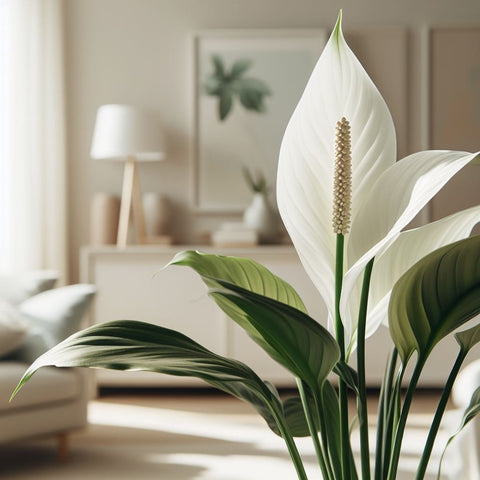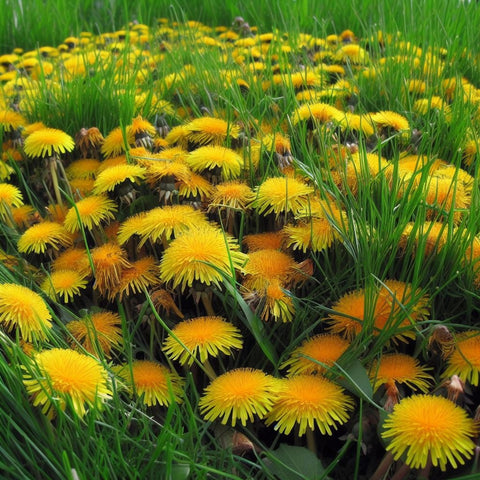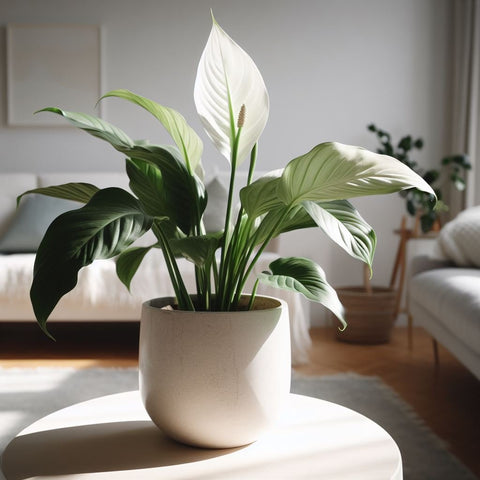Understanding the Peace Lily Spathiphyllum Wallisii
The peace lily spathiphyllum wallisii, with its graceful appearance and air-purifying qualities, has become a popular choice for indoor plants. This tropical plant is native to the rainforests of Central and South America. It is characterized by its glossy dark green leaves and beautiful white flowers, resembling a calm and serene lily.
To ensure the healthy growth of your peace lily, it is important to recreate its natural habitat as closely as possible. The ideal growing conditions for the peace lily include a temperature range of 65-85°F (18-29°C), bright but indirect sunlight, and high humidity levels.
Indoor plants are perfect for adding a touch of nature to your home or office. The peace lily is an excellent choice with its elegant appearance and its ability to purify the air, making your space more comfortable and inviting.
Benefits of Having a Peace Lily
One of the main reasons why peace lilies are so popular is their ability to purify the air. They have been proven to remove harmful toxins like formaldehyde, benzene, and trichloroethylene from the atmosphere, resulting in improved air quality. This can have a positive impact on your health, reducing allergies and respiratory problems.
In addition to their air-purifying properties, peace lilies have also been found to promote mental well-being. The presence of plants indoors has been linked to reduced stress levels and increased productivity. The peace lily, with its lush green foliage and elegant white flowers, can create a calming and relaxing atmosphere, enhancing your overall well-being.
Another advantage of peace lilies is their low-maintenance nature. They are relatively easy to care for and can adapt to different environments. They are known for their resilience and ability to recover from neglect, making them a suitable choice for beginners or busy individuals.
Caring for Your Peace Lily
Proper watering is crucial for the health of your peace lily. It is important to maintain a balance between under-watering and overwatering. Water the plant thoroughly when the top inch of soil feels dry to the touch, and ensure proper drainage to prevent waterlogging. Avoid letting the plant sit in standing water, as it can lead to root rot.
Fertilizing your peace lily is also important for healthy growth. Use a balanced, water-soluble fertilizer once a month during the growing season (spring and summer) and reduce or eliminate fertilization during the dormant period (fall and winter).
Peace lilies prefer a well-draining potting mix rich in organic matter. Regularly check the soil moisture level to prevent overwatering. If the leaves start to turn yellow, it may be a sign of overwatering, while brown tips can indicate underwatering.
The peace lily is generally a resilient plant, but it can face common issues such as pest infestations by spider mites and mealybugs. Regularly inspect the leaves for any signs of pests and treat them promptly with organic insecticidal soap or by wiping the leaves with a mild soapy solution.
Real-World Exploration
Many individuals have experienced the positive impact that peace lilies can have on their environment and overall well-being. Incorporating peace lilies into your home or office can create a serene and inviting space, promoting a sense of tranquility and harmony. They are often used as decorative accents in living rooms, bedrooms, and offices, providing a touch of natural beauty and elegance.

Insights
The peace lily spathiphyllum wallisii is a captivating indoor plant with its graceful appearance and air-purifying qualities. By understanding its origins, benefits, and care requirements, you can create an optimal environment for your peace lily to thrive. Incorporating peace lilies into your indoor space can not only beautify your surroundings but also provide numerous health benefits and enhance your overall well-being.
How do I propagate a peace lily?
Propagating a peace lily can be done through division. Carefully separate the plant into smaller sections, ensuring that each section has healthy roots and shoots. Plant the divisions in separate pots with well-draining soil and keep them in a warm and humid environment until established. Regular watering and care are essential for successful propagation.
Can peace lilies be grown in low-light conditions?
Peace lilies are known for their adaptability to low-light conditions, making them suitable for spaces with limited natural light. While they can tolerate lower light levels, they still require some indirect sunlight to thrive. Place your peace lily near a north-facing window or in a room with bright, indirect light to ensure healthy growth.
Are peace lilies toxic to pets?
Peace lilies are considered mildly toxic to cats, dogs, and other pets if ingested. The plant contains calcium oxalate crystals, which can cause irritation and discomfort if chewed or ingested. To ensure the safety of your pets, keep peace lilies out of their reach or consider choosing non-toxic alternatives for your indoor plants.






























Comments (0)
There are no comments for this article. Be the first one to leave a message!